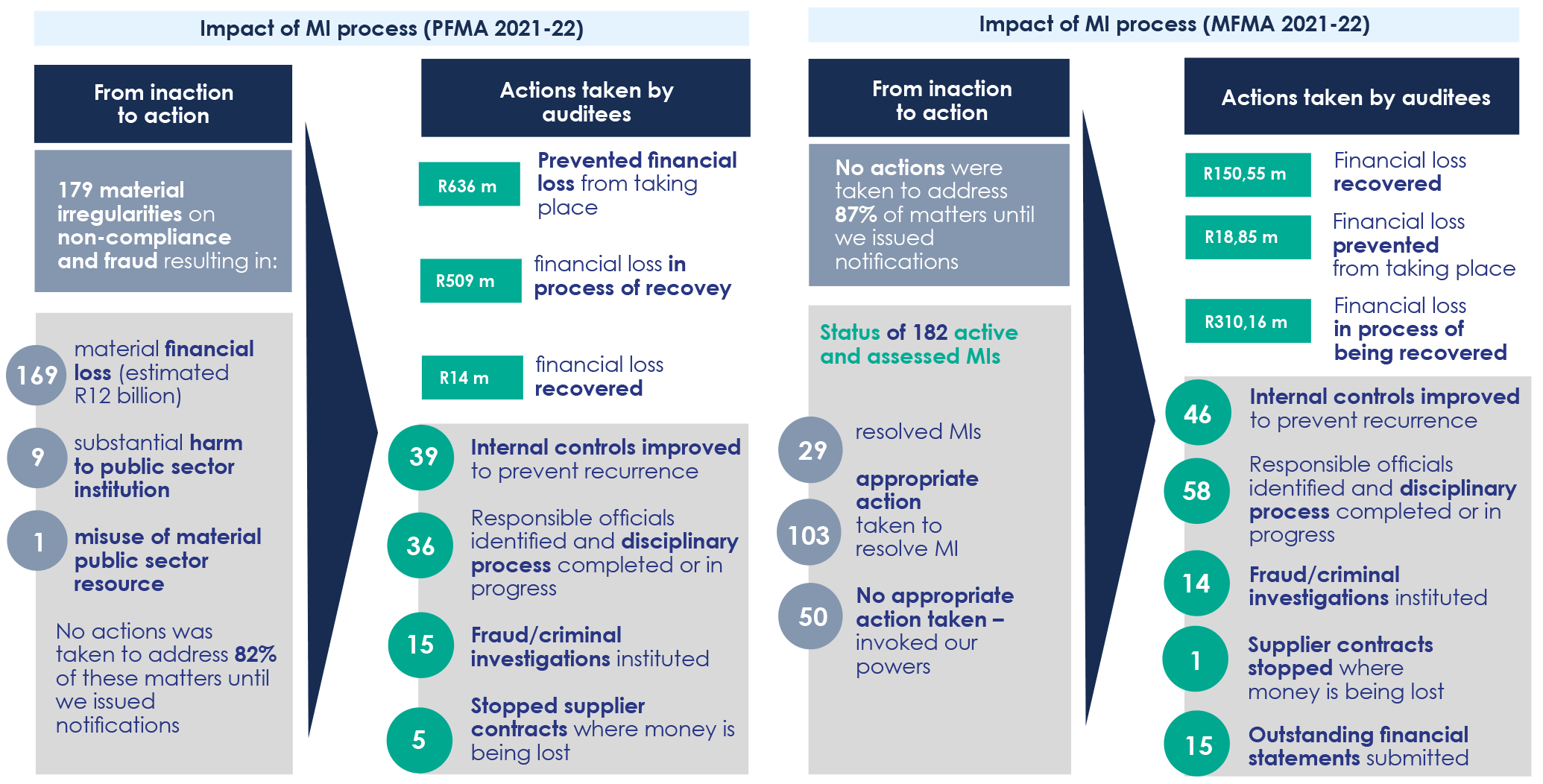Implementing the material irregularity (MI) process (our enhanced powers)
Over the past four years we have increasingly implemented all the elements of the material irregularity concept and increased the number of auditees at which we implemented the material irregularity process. We focused on auditees where we could have the greatest impact, using our resources optimally to ensure the quality of our processes.
The overall aim of our enhanced powers is to:

Definition of material irregularity and expanded powers

For more on our expanded powers and the material irregularity process visit the MI explained page on our website.
In 2022-23 we expanded our work significantly for the 2021-22 audit cycle by implementing the material irregularity process at 202 public sector institutions that we audit in national and provincial government and 170 in local government, in line with reaching our target of 42% breadth of implementation.
Our material irregularity implementation plan – an incremental approach
While expanding the breadth of our material irregularity process, we also began to focus on its impact.

The statistics of assets recovered and losses prevented, and the change in behaviour, point to the success of the material irregularity process. At the same time, we enhanced the material irregularity methodology and guidance to streamline the process and strengthened our collaboration and relationships with public bodies such as the Special Investigating Unit (SIU) and the Public Protector. It is important to reflect that we have not observed any legal challenges emanating from the material irregularity process implementation, which is an indirect indicator of the good design and application of the process.
Collaboration between our regularity auditors and our specialised audit services helped to strengthen the quality of the material irregularities raised.
Our technical specialists developed or updated guidance to support the audit teams on a variety of topics, and specifically in areas where we are building expertise such as matters relating to substantial harm to the general public or a public sector institution, or misuse of a material resource.
We continued to mitigate against potential risks to our audit quality during the material irregularity process by subjecting selected audits to independent reviews, and widely sharing the lessons learnt throughout the organisation.
We established an MI think tank to continuously enhance the material irregularity process, explore potential macro-environmental based MIs and ensure better stakeholder relations and communication protocols.
Case Management System (CMS)
The CMS was a key milestone for the organisation as the system is critical for streamlining the material irregularity process, reducing audit inefficiencies and mitigating risks linked to the management of the large number of material irregularities as we increase the breadth of implementation.
The rollout of this system to the end users is in progress and we look forward to realising the intended benefits in the next financial year.
Challenges in the implementation of the material irregularity process

Conclusion
The implementation of our enhanced powers continues with the intended speed and at the desired quality. Directly or indirectly, we have begun to observe that resources lost to the state have been recovered and consequences have been applied for wrongdoing. We are encouraged by the observed impact of our material irregularity process. Our intention is to review the process in its entirety, to assess the supporting policies and regulations, and to continue strengthening our capacity for implementation.
Our various platforms of engagement have helped increase stakeholders’ understanding of the material irregularity process, our role in identifying material irregularities, and the responsibilities of other roleplayers. Multi-year audit planning and our work with various roleplayers in the accountability ecosystem are complementary mechanisms that we will widely leverage to identify and process impactful material irregularities.

